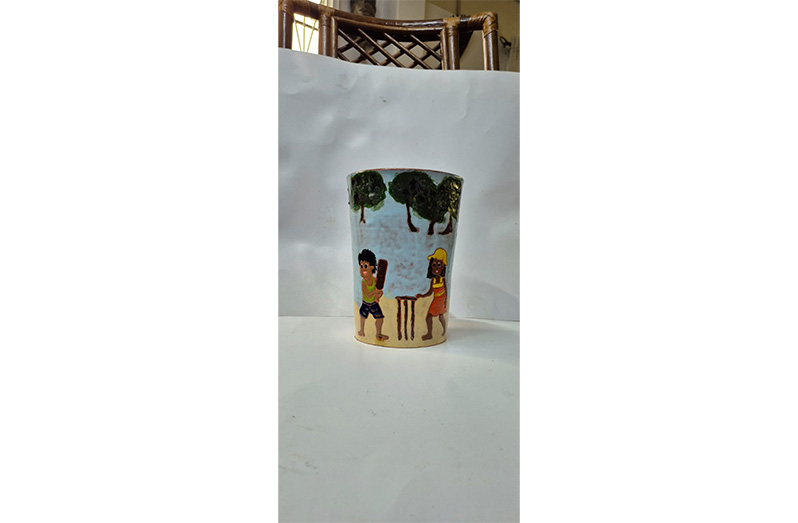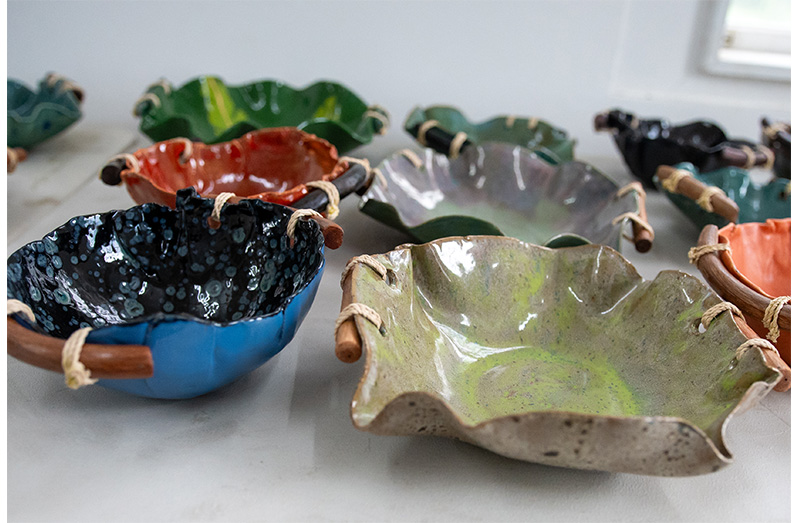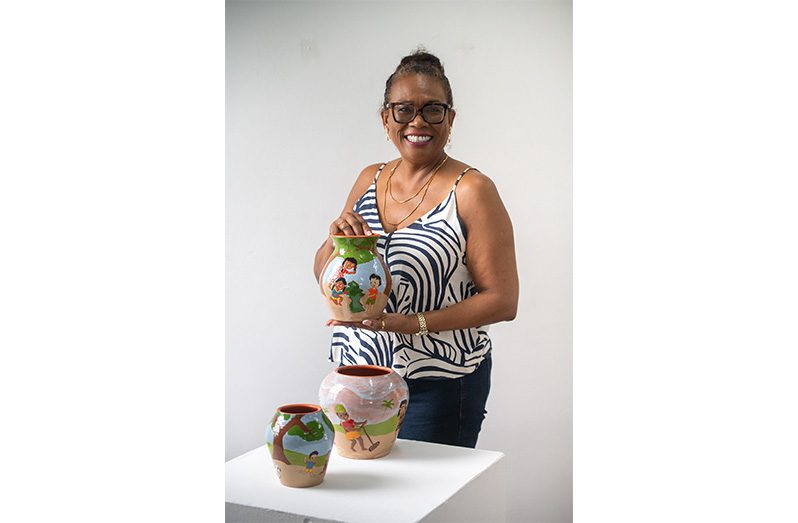Artist Lisa Thompson debuts her storytelling pottery pieces in her solo art exhibition, “Guyana: The Stories She Told”
FOR most Guyanese, games like hopscotch, jacks, or cricket shape our childhood. Youthful adventures of swimming through blackwater canals and playing among the trees are all too familiar to many Guyanese and tend to evoke a sense of nostalgia. That all-too-familiar taste of nostalgia is what artist Lisa Thompson has recreated with her pottery exhibition, Guyana: The Stories She Told.
The exhibition, which kicks off this weekend at Castellani House, features some 120 handcrafted pieces by Thompson, but her pieces are more than your typical vase. Thompson uses her pottery as a medium for storytelling, featuring hand-painted, picturesque scenes that evoke childhood memories. In her sit-down with the Pepperpot Magazine this week, Thompson stated that her work is a unique reflection of the authentic Guyanese experience.
Born and raised on the Essequibo Coast, Lisa Thompson is an activist for everything Guyanese. When she’s not moulding and glazing clay into bright, vibrant pottery pieces that tell stories, Thompson is the Project Director and Country Representative for a government-funded project focused on improving access to justice for Indigenous women and girls.

Pottery, for her, began simply as a hobby. While in Canada during the pandemic, Thompson learned pottery from a neighbour and fellow potter. This, she says, is where her love for transforming raw clay into something more began. “I remembered my sister had once gifted me a piece of pottery for the baby, and I absolutely loved it. I thought, ‘My God, I want to learn how to do this thing.’” She further added, “So my sister and I went every day for two weeks. Once I felt the clay, it was over.”
Since then, and upon her return to Guyana, Thompson has worked to refine her skills. Pottery, she shared, is a complex art form that requires patience. Highlighting her journey, Thompson noted that it has been a learning process, but one made possible by the support of friends and family. “By the time I got back to Guyana, my husband had already bought me a kiln and a second-hand potter’s wheel from a local potter. He also gave me my first bit of clay and taught me how to process it. You don’t just dig clay and use it — you have to dilute it into a thick soup, strain it through mesh, let it settle and dry until it’s like clay dough, then knead it to remove impurities before you can start working.”
In a conversation with Pepperpot Magazine about her creative process, Thompson described pottery as something that cannot be rushed. “Pottery is not something you can rush. It teaches patience and focus. When you make something, you must allow it to dry for at least two weeks before doing the first firing, called a bisque fire. That’s when the piece turns into that orange-looking ceramic,” she further explained. “The firing takes four hours and reaches 1,500 degrees Fahrenheit, then takes 16 hours to cool. You can’t just ask me for a vase and expect it tomorrow. Then comes glazing; each glaze must be brushed on three times, inside and out, drying in between, before it’s fired again.”
During her creative process, Thompson had a new idea — one that she says has shifted her art. She began creating vases, of all sizes, painted with bold colours, each telling a different story. The first ‘storytelling’ piece she created featured the iconic game of cricket and depicted children of all shades. Thompson shared that she wanted to create something that all Guyanese, of all ages, could relate to and see themselves in. “I always have ideas running through my head, and I love children and storytelling. One day, I thought, ‘Let me try a vase with cricket.’ I doubted myself because I don’t draw well, but I did it anyway. I wanted it to look like a sunny day, with children in different shades of brown, with different hair types. I loved the result. When I showed it to a friend, she said it was beautiful and suggested hopscotch. That led to more childhood memories — Chinese skipping, swimming in the blackwater trench,” she shared.
For Thompson, a proud Essequibo native, her work is inspired by real memories; memories that most Guyanese share. “I grew up on the Essequibo Coast in a village called Adventure. On weekends, my siblings and I would sneak away to swim, no adults in sight. I created vases of those memories — swimming, using palm fronds as boats, slingshots made from tree branches and old tyres, paper boats sailing in puddles. I have over 60 of these story-filled vases in the exhibition,” she shared. Those 60 pieces make up half of the 120 pieces in Thompson’s exhibition, which will run from August 8th to the 21st.

However, the road to transforming these memories into hand-painted realities has been marked by several hurdles. Although pottery in Guyana is a growing art form, with more workshops emerging and more artists turning to the medium, obtaining materials — especially on a large scale — remains a challenge, says Thompson. “Materials are the biggest challenge. In Canada, you would just go to the store and buy a 50-pound box of ready-to-use clay. Here, we dig clay from trenches or roadside spots; people even call me to tell me where good clay is.” She added, “But the process to clean and prepare it takes over a week of hard, physical work. The glazes I use are imported, expensive, and subject to high duty. Then there’s the electric kiln. The cost of materials is high for all artists, and while we can use local clay, the preparation is intense. So, anyone who creates here is doing it out of love.”
Thompson’s work stands out not just for the storytelling but for its vibrancy and raw Guyanese authenticity. As the exhibition takes flight this weekend, Thompson hopes that people walk away understanding that her work is more than just art; for her, it’s about connection and reflection. “What I hope people take away is that this is more than just art; it’s about seeing yourself reflected in something beautiful. It’s about connecting with your childhood, your culture. Even if people don’t buy anything, I want them to come, look, enjoy, and immerse themselves.” She further shared, “Exposure to art is always a good thing, and this collection is unique. We’ve never had an exhibition of only pottery in Guyana, far less one focused entirely on Guyanese childhood memories. It’s incredibly humbling to be the first to do that.”
Although the event is now underway, Thompson is already thinking about her next venture and is captivated by the idea of using other mediums to tell stories, such as Anansi tales, through her work. But whether it’s through her craft or her activism, Thompson says she is sure she will continue to tell the Guyanese story — one way or another.


.jpg)











